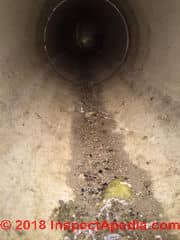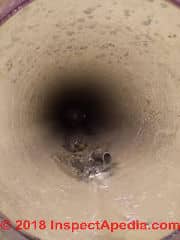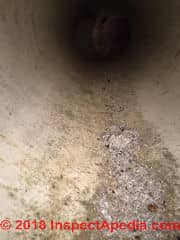 In-Slab Air Duct FAQs-3
In-Slab Air Duct FAQs-3
Recent Q&A on HV
AC Ducts in Floor Slabs
- POST a QUESTION or COMMENT about HVAC air ducts placed in or below concrete floor slabs
Slab ductwork contamination, leaks, mold diagnosis & repair or abandonment FAQs, set #3
This article series describes heating and air conditioning ducts that have been placed in or beneath concrete floor slabs.
InspectAPedia tolerates no conflicts of interest. We have no relationship with advertisers, products, or services discussed at this website.
- Daniel Friedman, Publisher/Editor/Author - See WHO ARE WE?
FAQs on HVAC air ducts in concrete floor slabs
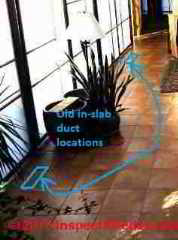 These questions & answers about diagnosing & fixing problems traced to in-slab air ducts were posted originally
These questions & answers about diagnosing & fixing problems traced to in-slab air ducts were posted originally
at SLAB DUCTWORK - topic home. Be sure to see the in-slab ductwork description, problem identification and solutions described there.
On 2019-10-06 by (mod) - why your underground return air duct is flooded
Jim
Sorry but from etext alone I can't say for sure why your underground return air duct is flooded; Considering that you're in a dry area and have had no rain and have not run a watering system that could have flooded the duct from outside, I'd be looking for a plumbing source such as condensate drainage or a leak supply or drain line.
For example readers have on occasion found a sewer line that leaked into the duct system.
Combine looking for those potential sources with pumping out the duct and inspecting it using a sewer line camera. Let me know what you're told.
Also see WATER & ICE IN DUCT WORK
On 2019-10-06 by Jim E
Ths 4 to 6 inches, not 40 to 6.:-)
I currently have 40 t0 6 inches of water in my underground cement air return.
I have no clue how the water got there. Any suggestions?
I live in a very dry and arid location in Scottsdale Arizona so I know it's not because of rain or watering the lawns.
On 2019-09-26 by (mod) - Is it necessary to fill in entire old ducts in slab with concrete?
Cathy
While I prefer to fill in old ducts entirely - avoiding risk of having a standing pool of nasty water under a slab, waiting to find a way into the building - it's also common to block off and fill all of the supply and return points and to eschew a total fill-in.
Keep in mind that you can't assure not future trouble; for example a slab crack hidden under carpeting can vent odors, bacteria, mold into the occupied space should such occur in in-slab abandoned ductwork. In some areas radon may also be a concern.
To be candid, in a NY home that we used as the photo model for some of the in-slab-duct abandonment discussion in this article series, we filled in and sealed only the supply and return openings in the slab and left some in-slab ducts empty;
however that home has no carpeting; ceramic tile covers the interior floors; we were confident that we'd quickly see any evidence of a future crack or opening or leak into the building - an annoyance that hasn't come up in the 20 years since that job was completed in our example home.
On 2019-09-26 by cathy
My daughter and my grandchildren constantly sick. Noticed nasty old vents in slab floor.
Put in all new HVAC System in attic. Is it necessary to fill in entire old ducts in slab with concrete? I was told there is 4 inches of concrete on top of the old ducts and it would not cave in. We just want to seal it up right and without moisture leaving old system. Please advise
On 2019-07-13 by (mod) - I have in slab duct work
I want to help but don't have a clear understanding of the situation; maybe you could attach a sketch or photo - one per comment - to help me get the picture.
Basically in-slab ducts are going to be trouble; one approach is to abandon that design entirely. That's what I prefer.
On 2019-07-13 by Anonymous
I have in slab duct work. This year I had to replace the two swamp coolers ...
prior to removing the ground level one, i started it up and TONs of dirt came into the house. after removing the bottom swamp cooler we found the the duct work had be compromised.. the duct work and concrete had rusted away... and at the top of the opening is where we think the dirt was coming from.
I cleaned out the all the old duct work and alot the of dirt that was exposed. It was then concreted ... the first day i got dirt coming out... but then the next couple of days was good, the 3 day... tons of dirt again...
I have vacuumed the ducts with a shop vac going in approx 10 ft at each register.... the one in the office has rusted away to the dirt.
(how can i fix that? ) and is the only way to know if the ducts are compromised in the ducts under the slab by calling a duct cleaning company? or do I call a HVAC company... I am in new mexico.... .. thank you
On 2019-05-28 by Jerry
Ive abandon the slab ducts. Like to have them filled. Any recommendations in the Md area who this job
On 2019-03-24 by (mod) -
Joel
Yep darn it I have had that problem too - water leaks into the abandoned ducts - which ought to make you feel good that you abandoned using them for heating or cooling.
IMO any cement mix that you can pump in to and pretty much fill the ducts with will work - after all it doesn't have to be structurally strong. Discuss with your concrete contractor whether or not they can pump a suitable mix into the ducts with a minimum number of pumping points. I prefer to pump from one end and watch the other end to see the concrete arrive - thus I've probably minimized the voids.
On 2019-03-24 by Joel
We’ve abandoned our in-slab return ducts after remodeling. Currently the old slab ducts are not in use, but we’ve noticed some moisture accumulating after heavy rains, snow melt. I’d like to fill in the ducts completely with concrete, but not sure how to make sure the cement makes it all the way through the duct runs. I’m measuring about 65 feet total, 9” circular ducts.
I was researching the possibility of using a self-leveling cement, which is more of a liquid consistency and may do a better job of filling these long runs...any advice on this, or if there is another type of cement I can use that might work better (or less expensive)?
On 2018-12-31 by (mod) - Why is ductwork not fully open
Rose
ThatLooks like a mistake to me but as you know from this article series ducts in slabs are often going to be problematic anyway.
On 2018-12-30 by RoseSpanel
Why is ductwork not fully open
IMAGE LOST by older version of Clark Van Oyen’s useful Comments code - now fixed. Please re-post the image if you can. Sorry. Mod.
On 2018-10-04 by (mod) -
Debbie
Often the HVAC installer/designer has to make compromises to fit the system to the house. And, with apologies, I can't know enough from a brief text to have a full, confident opinion.
In general:
Optimum return air for heating systems is near the floor where it picks up cooler air;
Better return air location is to keep it some distance from the supply air for both heating and cooling, to avoid a short circuit in the system.
Taking return air at a fireplace could interfere with fireplace draft, but, then, building a new home you ought to be providing outdoor air to the fireplace so as to avoid that issue in the first place; otherwise the fireplace just sucks heat out of the home.
On 2018-10-04 by Debbie
We are building a 1900 square foot one level home on a slab. No basement, no upstairs. The heat vents are all located in the ceilings. I noticed two cold air return vents in an area where we will have a built in cabinet. So they raised the cold air vents to the ceiling. These air vents are also located within inches of our fireplace. Is this ok, or will it cause inefficiency in our heating/air conditioning.
Reader Question: are these dirty plastic in-slab ducts ok in my Minnesota home?
Hi, I just had a home inspected in Minnesota and I'm not sure how to interpret the photos of the sub-slab PVC ducts in the basement floor.
Most of the sand/dirt is in the ducts on the front side of the house, one of them close to the entrance to the basement from upstairs.
The radon levels were good for MN (2 pCi/L) I'm curious what your professional opinion is, if this ductwork is likely OK (after cleaning it and getting sand out), or if it has signs of water or mold.
Note the PVC ducts are all PVC and joints appear to have a reddish glue sealing them together.
There are no other signs of water problems in the house and it does not have a sump pump in the basket. It's a 2-story walkout and the backyard is relatively flat - the left side of the yard does go uphill a few feet to the neighboring lot.
The ground behind the house was a little moist ( there is no gutter along the back-side and the grade of land next to the house could be improved a bit)
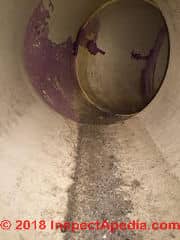 This is the official report from the inspector:
This is the official report from the inspector:
"Sub slab ducts are dirty in areas. Appears there has been water in the ducts at some time, could of been at time of construction or any time after.
The drain tile below the basement floor is not at a elevation below the sub slab ductwork. This can be a significant concern and costly to correct if there are issues with elevated ground water."
The inspector also indicated he thinks the system is probably OK since it's using PVC, since the joints are sealed with something, but said he can't determine if the water/sand entered during construction or over time (the house was made in '95).
Thanks in advance,
- Anonymous by private email
Reply by (Mod) - clean the duct system, monitor for water entry
Kudos to your inspector for spotting these dirty duct conditions and for her familarity with in-slab duct issues.
I see dirt, a scrap of fiberglass insulation, and what looks like rodent droppings, and in some photos what could be marks left behind by water marks.
If the photos were larger high-res files I'd have zoomed in for a closer look.
It's encouraging if a complete duct inspection by camera finds no water right now but that doesn't absolutely assure us that water's never present.
At the very least I'd have the duct system cleaned and then I'd re-inspect during the wet season for MN - which where you are is probably in May or June.
Watch out: keep in mind that even if ground water is not leaking directly into the duct system, an in-slab duct system may also get wet from condensation.
I presume you know my opinion on in-slab ductwork from articles
at SLAB DUCTWORK right?
...
Continue reading at SLAB DUCTWORK or select a topic from the closely-related articles below, or see the complete ARTICLE INDEX.
Or see these
Recommended Articles
- ASBESTOS TRANSITE DUCTWORK
- DUCT & AIR HANDLER ODORS
- PVC HVAC DUCTS
- SLAB DUCTWORK
- WATER & ICE IN DUCT WORK
- WET CORRODED DUCT WORK
Suggested citation for this web page
SLAB DUCTWORK FAQs-3 at InspectApedia.com - online encyclopedia of building & environmental inspection, testing, diagnosis, repair, & problem prevention advice.
Or see this
INDEX to RELATED ARTICLES: ARTICLE INDEX to HVAC DUCT SYSTEMS
Or use the SEARCH BOX found below to Ask a Question or Search InspectApedia
Ask a Question or Search InspectApedia
Try the search box just below, or if you prefer, post a question or comment in the Comments box below and we will respond promptly.
Search the InspectApedia website
Note: appearance of your Comment below may be delayed: if your comment contains an image, photograph, web link, or text that looks to the software as if it might be a web link, your posting will appear after it has been approved by a moderator. Apologies for the delay.
Only one image can be added per comment but you can post as many comments, and therefore images, as you like.
You will not receive a notification when a response to your question has been posted.
Please bookmark this page to make it easy for you to check back for our response.
IF above you see "Comment Form is loading comments..." then COMMENT BOX - countable.ca / bawkbox.com IS NOT WORKING.
In any case you are welcome to send an email directly to us at InspectApedia.com at editor@inspectApedia.com
We'll reply to you directly. Please help us help you by noting, in your email, the URL of the InspectApedia page where you wanted to comment.
Citations & References
In addition to any citations in the article above, a full list is available on request.
CONTINUE READING or RECOMMENDED ARTICLES.
- Carson, Dunlop & Associates Ltd., 120 Carlton Street Suite 407, Toronto ON M5A 4K2. Tel: (416) 964-9415 1-800-268-7070 Email: info@carsondunlop.com. Alan Carson is a past president of ASHI, the American Society of Home Inspectors.
Thanks to Alan Carson and Bob Dunlop, for permission for InspectAPedia to use text excerpts from The HOME REFERENCE BOOK - the Encyclopedia of Homes and to use illustrations from The ILLUSTRATED HOME .
Carson Dunlop Associates provides extensive home inspection education and report writing material. In gratitude we provide links to tsome Carson Dunlop Associates products and services.


